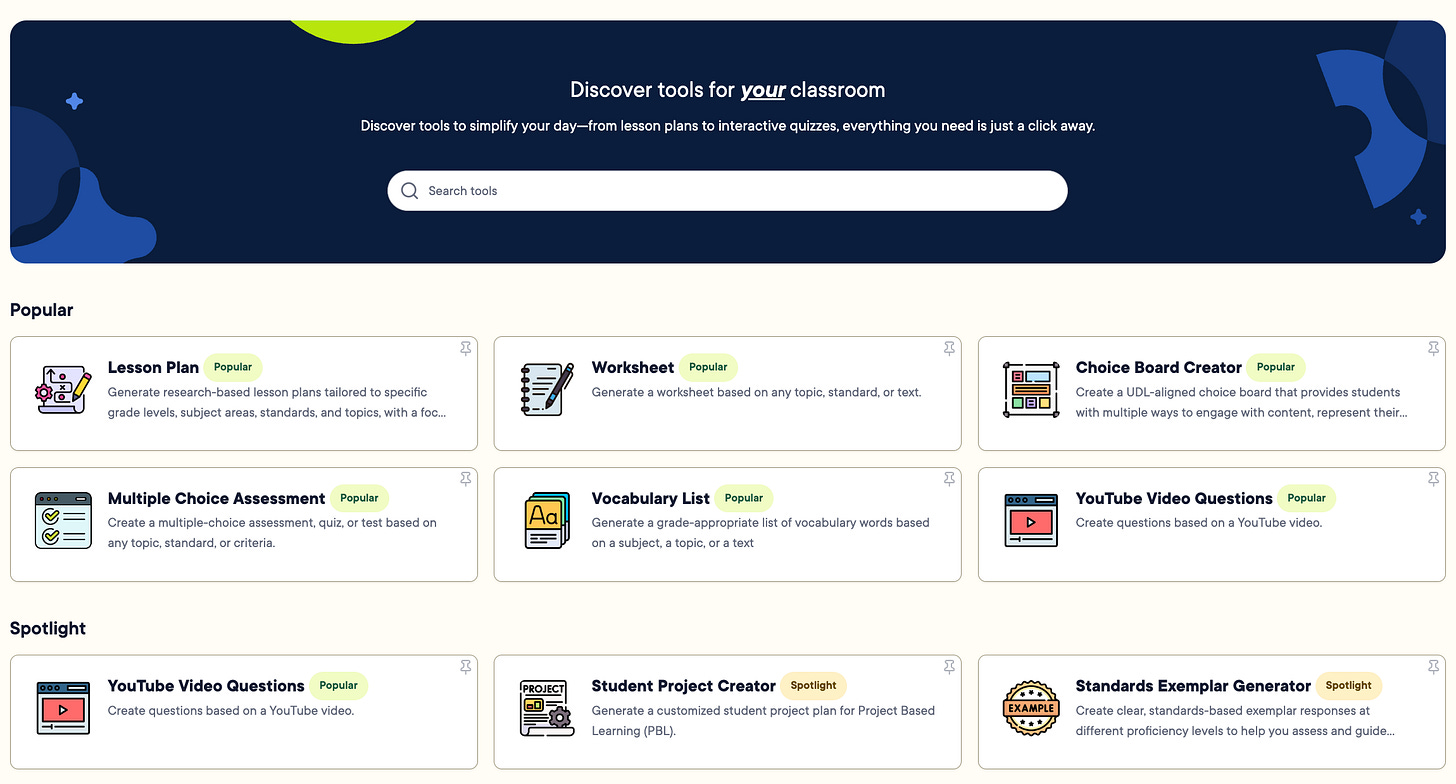As we went to print: As this newsletter went to schedule-send, the Trump Administration won a suit in the Supreme Court to fire over 1,500 Department of Education employees. Linda McMahon will now dismantle the agency in its entirety. With the end of the federal DOE in sight, it almost makes what we were going to write even more vacuous (which is maybe the point).
Our regularly planned schedule
Generative AI has unleashed an overabundance of content across platforms: People can create video games on ChatGPT with simple prompts, generate video with Kling, and even record a podcast. Tools like Knowlify, a YC startup, let you generate “Khan Academy-style educational videos” in seconds from text. While social media reduced the barriers to disseminating content, AI has reduced the barriers to creating content.
I had the fortune of attending ISTE the other week, and 99% of the companies there were talking about AI. MagicSchool felt a bit like the belle of the ball.
Pear Deck has their dupe of MagicSchool.

Kahoot lets you upload a PDF and it’ll make a deck for you with interactive questions. Google Gemini unveiled a barrage of new features.
Some of it’s okay. I have my philosophical qualms with an education technology company being almost exclusively about AI (as opposed to, say, the substantive things that AI is meant to do in education).
All of these tools create. But what they create is of questionable value. Look at the studies showing kids are quickly losing critical thinking ability when they depend on AI, or Grok getting taken offline, or misinformation spreading. AI is revolutionizing education. It is destroying, in a matter of months, what the Educational Industry (and other industries) have taken decades (or centuries) to make. Some of that is fine. Democratizing the ability to create things, especially decent quality things, is good. But it also undermines the societal benefit that experts provide–and decrease the pool of possible experts.
Smaller pool of people; bigger pool of AI
When everyone can make mediocre graphic art (or Studio Ghibli profiles), then why even invest in those skills? I ask this rhetorically, but it’s what’s happening to the market. Demand for certain (all?) jobs will decrease, which means fewer people will pursue the upskilling path to attain those jobs, which means the talent pipeline is smaller. Who knows if we’d have that brilliant mathematician or coder or animator if the talent pool shrinks? Goldman hired an AI employee
All sizzle, no steak
Think of all that content! Billions of lessons generated by simple prompts.
“Make me a lesson / worksheet / assessment that addresses this math standard.”
“Make it more engaging.”
“Make it last forty minutes.”
Each lesson, costing us a cumulatively frightening amount of water, but whatever. That’s the cost of progress. But how much of this is good content? Studies show that students “get stupider” when they relied on ChatGPT, after all.
He opened Claude on his laptop. I noticed a chat that mentioned abolition. “We had to read Robert Wedderburn for a class,” he explained, referring to the nineteenth-century Jamaican abolitionist. “But, obviously, I wasn’t tryin’ to read that.”
- Hua Hsu, “What Happens After A.I. Destroys College Writing?” The New Yorker
What happens to all of our brains when we just default to AI? And I want to give credit to educators. They’ll use AI responsibly! Maybe. Hopefully? But here’s the thing. These college students succumbing to irresponsible1 AI use have as much choice in the matter as a dodo choosing to lay its eggs on the ground.
None of us are prepared.
My two cents, walking around ISTE, was that a lot of this will be washed away in a year. Yes, AI is and will revolutionize everything. But it felt a little frothy. So many companies, with GPT-wrappers, soaking up all this attention. No moat, aside from maybe some branding. No expertise moat. There were some legitimately amazing booths at ISTE: Deep tech startups teaching kids about STEM with robotics, project-based learning with 3D printers, several booths on physical education and augmented reality. And yet the things that got people in the booths were GPT wrappers, with their flashy demos and cool swag.
How can teachers resist, when 99% of the booths / tools / companies throwing content at their faces are AI? How can society? My only consolation is the bubble will burst, and we’ll be left with, ideally, the best–or the deepest pocketed–tools. And then quality / expertise will become a differentiator again.
Miss our announcement last week?
Michael and I are launching a podcast! Talk about overabundance of content! Ours is also just at the start of the learning curve (I realize I audibly agree a lot in podcasts. Big yikes).
Check it out on Spotify below! You can also find us on Apple. Our first episode releases July 22 on Substack for paid subscribers, and on July 29 on Spotify, Substack, Apple, and more for everyone.
Next week we’re going to dig into the Trump Administration’s dismantling of the Department of Education (and sing a sad dirge for it) and the McGraw Hill IPO ($4.2B, down from their sale to PE in 2021 for $4.5B).
Is it irresponsible? The NYU student in that New Yorker article above gets good grades with barely lifting a finger.








